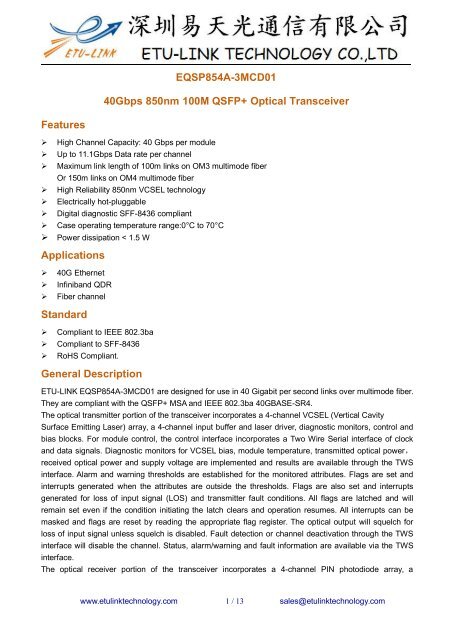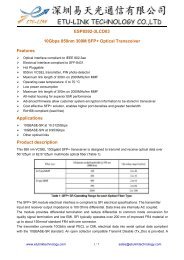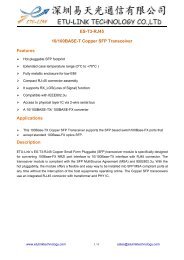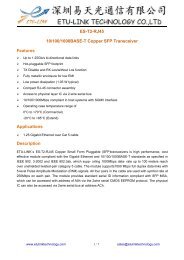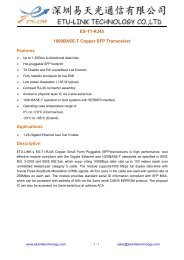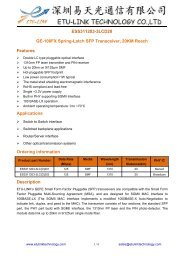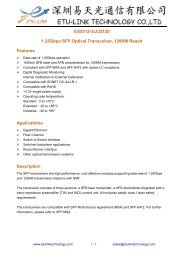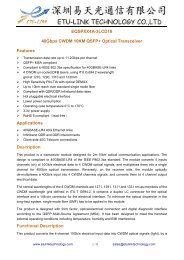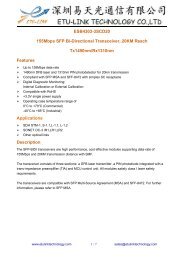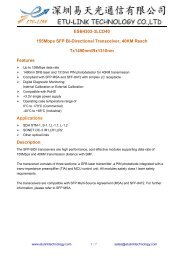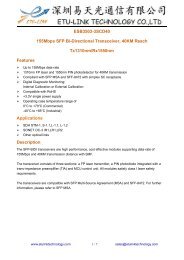EQSP854A-3MCD01
ETU-LINK EQSP854A-3MCD01 are designed for use in 40 Gigabit per second links over multimode fiber. They are compliant with the QSFP+ MSAand IEEE 802.3ba 40GBASE-SR4. The optical transmitter portion of the transceiver incorporates a 4-channel VCSEL (Vertical Cavity Surface Emitting Laser) array, a 4-channel input buffer and laser driver, diagnostic monitors, control and bias blocks. For module control, the control interface incorporates a Two Wire Serial interface of clock and data signals. Diagnostic monitors for VCSEL bias, module temperature, transmitted optical power, received optical power and supply voltage are implemented and results are available through the TWS interface. Alarm and warning thresholds are established for the monitored attributes. Flags are set and interrupts generated when the attributes are outside the thresholds. Flags are also set and interrupts generated for loss of input signal (LOS) and transmitter fault conditions. All flags are latched and will remain set even if the condition initiating the latch clears and operation resumes. All interrupts can be masked and flags are reset by reading the appropriate flag register. The optical output will squelch for loss of input signal unless squelch is disabled. Fault detection or channel deactivation through the TWS interface will disable the channel. Status, alarm/warning and fault information are available via the TWS interface.
ETU-LINK EQSP854A-3MCD01 are designed for use in 40 Gigabit per second links over multimode fiber.
They are compliant with the QSFP+ MSAand IEEE 802.3ba 40GBASE-SR4.
The optical transmitter portion of the transceiver incorporates a 4-channel VCSEL (Vertical Cavity
Surface Emitting Laser) array, a 4-channel input buffer and laser driver, diagnostic monitors, control and
bias blocks. For module control, the control interface incorporates a Two Wire Serial interface of clock
and data signals. Diagnostic monitors for VCSEL bias, module temperature, transmitted optical power,
received optical power and supply voltage are implemented and results are available through the TWS
interface. Alarm and warning thresholds are established for the monitored attributes. Flags are set and
interrupts generated when the attributes are outside the thresholds. Flags are also set and interrupts
generated for loss of input signal (LOS) and transmitter fault conditions. All flags are latched and will
remain set even if the condition initiating the latch clears and operation resumes. All interrupts can be
masked and flags are reset by reading the appropriate flag register. The optical output will squelch for
loss of input signal unless squelch is disabled. Fault detection or channel deactivation through the TWS
interface will disable the channel. Status, alarm/warning and fault information are available via the TWS
interface.
You also want an ePaper? Increase the reach of your titles
YUMPU automatically turns print PDFs into web optimized ePapers that Google loves.
<strong>EQSP854A</strong>-<strong>3MCD01</strong><br />
40Gbps 850nm 100M QSFP+ Optical Transceiver<br />
Features<br />
‣ High Channel Capacity: 40 Gbps per module<br />
‣ Up to 11.1Gbps Data rate per channel<br />
‣ Maximum link length of 100m links on OM3 multimode fiber<br />
Or 150m links on OM4 multimode fiber<br />
‣ High Reliability 850nm VCSEL technology<br />
‣ Electrically hot-pluggable<br />
‣ Digital diagnostic SFF-8436 compliant<br />
‣ Case operating temperature range:0°C to 70°C<br />
‣ Power dissipation < 1.5 W<br />
Applications<br />
‣ 40G Ethernet<br />
‣ Infiniband QDR<br />
‣ Fiber channel<br />
Standard<br />
‣ Compliant to IEEE 802.3ba<br />
‣ Compliant to SFF-8436<br />
‣ RoHS Compliant.<br />
General Description<br />
ETU-LINK <strong>EQSP854A</strong>-<strong>3MCD01</strong> are designed for use in 40 Gigabit per second links over multimode fiber.<br />
They are compliant with the QSFP+ MSA and IEEE 802.3ba 40GBASE-SR4.<br />
The optical transmitter portion of the transceiver incorporates a 4-channel VCSEL (Vertical Cavity<br />
Surface Emitting Laser) array, a 4-channel input buffer and laser driver, diagnostic monitors, control and<br />
bias blocks. For module control, the control interface incorporates a Two Wire Serial interface of clock<br />
and data signals. Diagnostic monitors for VCSEL bias, module temperature, transmitted optical power,<br />
received optical power and supply voltage are implemented and results are available through the TWS<br />
interface. Alarm and warning thresholds are established for the monitored attributes. Flags are set and<br />
interrupts generated when the attributes are outside the thresholds. Flags are also set and interrupts<br />
generated for loss of input signal (LOS) and transmitter fault conditions. All flags are latched and will<br />
remain set even if the condition initiating the latch clears and operation resumes. All interrupts can be<br />
masked and flags are reset by reading the appropriate flag register. The optical output will squelch for<br />
loss of input signal unless squelch is disabled. Fault detection or channel deactivation through the TWS<br />
interface will disable the channel. Status, alarm/warning and fault information are available via the TWS<br />
interface.<br />
The optical receiver portion of the transceiver incorporates a 4-channel PIN photodiode array, a<br />
www.etulinktechnology.com 1 / 13 sales@etulinktechnology.com
4-channel TIA array, a 4 channel output buffer, diagnostic monitors, and control and bias blocks.<br />
Diagnostic monitors for optical input power are implemented and results are available through the TWS<br />
interface. Alarm and warning thresholds are established for the monitored attributes. Flags are set and<br />
interrupts generated when the attributes are outside the thresholds. Flags are also set and interrupts<br />
generated for loss of optical input signal (LOS). All flags are latched and will remain set even if the<br />
condition initiating the flag clears and operation resumes. All interrupts can be masked and flags are reset<br />
upon reading the appropriate flag register. The electrical output will squelch for loss of input signal (unless<br />
squelch is disabled) and channel de-activation through TWS interface. Status and alarm/warning<br />
information are available via the TWS interface.<br />
Absolute Maximum Ratings<br />
Parameter Symbol Min. Typ. Max. Unit Note<br />
Storage Temperature Ts -40 - 85 ºC<br />
Relative Humidity RH 5 - 95 %<br />
Power Supply Voltage VCC -0.3 - 4 V<br />
Signal Input Voltage Vcc-0.3 - Vcc+0.3 V<br />
Damage threshold 3.4 dBm<br />
Recommended Operating Conditions<br />
Parameter Symbol Min. Typ. Max. Unit Note<br />
Case Operating Temperature Tcase 0 - 70 ºC Without air flow<br />
Power Supply Voltage VCC 3.14 3.3 3.46 V<br />
Power Supply Current ICC - 350 mA<br />
Data Rate BR 10.3125 Gbps Each channel<br />
Transmission Distance TD - 100 m OM3 MMF<br />
150 m OM4 MMF<br />
Optical Characteristics<br />
Parameter Symbol Min Typ Max Unit NOTE<br />
Transmitter<br />
Center Wavelength λ0 840 860 nm<br />
Average Launch Power each lane -7.6 0.5 dBm<br />
Spectral Width (RMS) σ 0.65 nm<br />
Optical Extinction Ratio ER 3 dB<br />
Average launch Power off each lane Poff -30 dBm<br />
Transmitter and Dispersion Penalty each lane TDP 3.5 dB<br />
www.etulinktechnology.com 2 / 13 sales@etulinktechnology.com
Optical Return Loss Tolerance ORL 12<br />
dB<br />
Output Eye Mask<br />
Compliant with IEEE 802.3ba<br />
Receiver<br />
Receiver Wavelength λin 840 860 nm<br />
Rx Sensitivity per lane RSENS -9.5 dBm 1<br />
Input Saturation Power (Overload) Psat 2.4 dBm<br />
Receiver Reflectance Rr -12 dB<br />
LOS De-Assert<br />
LOSD<br />
-12 dBm<br />
LOS Assert LOSA -30<br />
LOS Hysteresis 0.5<br />
dBm<br />
dBm<br />
Notes:<br />
1) Measured with a PRBS 2 31 -1 test pattern, @10.325Gb/s, BER
Pin Assignment<br />
Figure 1---Pin out of Connector Block on Host Board<br />
Pin Symbol Name/Description NOTE<br />
1 GND Transmitter Ground (Common with Receiver Ground) 1<br />
2 Tx2n Transmitter Inverted Data Input<br />
3 Tx2p Transmitter Non-Inverted Data output<br />
4 GND Transmitter Ground (Common with Receiver Ground) 1<br />
5 Tx4n Transmitter Inverted Data Input<br />
6 Tx4p Transmitter Non-Inverted Data output<br />
7 GND Transmitter Ground (Common with Receiver Ground) 1<br />
8 ModSelL Module Select<br />
9 ResetL Module Reset<br />
10 VccRx 3.3V Power Supply Receiver 2<br />
11 SCL 2-Wire serial Interface Clock<br />
12 SDA 2-Wire serial Interface Data<br />
13 GND Transmitter Ground (Common with Receiver Ground)<br />
14 Rx3p Receiver Non-Inverted Data Output<br />
15 Rx3n Receiver Inverted Data Output<br />
16 GND Transmitter Ground (Common with Receiver Ground) 1<br />
17 Rx1p Receiver Non-Inverted Data Output<br />
18 Rx1n Receiver Inverted Data Output<br />
19 GND Transmitter Ground (Common with Receiver Ground) 1<br />
20 GND Transmitter Ground (Common with Receiver Ground) 1<br />
21 Rx2n Receiver Inverted Data Output<br />
www.etulinktechnology.com 4 / 13 sales@etulinktechnology.com
22 Rx2p Receiver Non-Inverted Data Output<br />
23 GND Transmitter Ground (Common with Receiver Ground) 1<br />
24 Rx4n Receiver Inverted Data Output 1<br />
25 Rx4p Receiver Non-Inverted Data Output<br />
26 GND Transmitter Ground (Common with Receiver Ground) 1<br />
27 ModPrsl Module Present<br />
28 IntL Interrupt<br />
29 VccTx 3.3V power supply transmitter 2<br />
30 Vcc1 3.3V power supply 2<br />
31 LPMode Low Power Mode,not connect<br />
32 GND Transmitter Ground (Common with Receiver Ground) 1<br />
33 Tx3p Transmitter Non-Inverted Data Input<br />
34 Tx3n Transmitter Inverted Data Output<br />
35 GND Transmitter Ground (Common with Receiver Ground) 1<br />
36 Tx1p Transmitter Non-Inverted Data Input<br />
37 Tx1n Transmitter Inverted Data Output<br />
38 GND Transmitter Ground (Common with Receiver Ground) 1<br />
Notes:<br />
1) GND is the symbol for signal and supply (power) common for QSFP+ modules. All are common within the QSFP+<br />
module and all module voltages are referenced to this potential unless otherwise noted. Connect these directly to the<br />
host board signal common ground plane.<br />
2) VccRx, Vcc1 and VccTx are the receiving and transmission power suppliers and shall be applied concurrently.<br />
Recommended host board power supply filtering is shown below. Vcc Rx, Vcc1 and Vcc Tx may be internally<br />
connected within the QSFP+ transceiver module in any combination. The connector pins are each rated for a<br />
maximum current of 500mA.<br />
Digital Diagnostic Functions<br />
ETU-LINK <strong>EQSP854A</strong>-<strong>3MCD01</strong> support the 2-wire serial communication protocol as defined in the<br />
QSFP+ MSA.,which allows real-time access to the following operating parameters:<br />
• Transceiver temperature<br />
• Laser bias current<br />
• Transmitted optical power<br />
• Received optical power<br />
• Transceiver supply voltage<br />
It also provides a sophisticated system of alarm and warning flags, which may be used to alert end-users<br />
when particular operating parameters are outside of a factory-set normal range.<br />
The operating and diagnostics information is monitored and reported by a Digital Diagnostics Transceiver<br />
Controller inside the transceiver, which is accessed through the 2-wire serial interface. When the serial<br />
protocol is activated, the serial clock signal (SCL pin) is generated by the host. The positive edge clocks<br />
data into the QSFP+ transceiver into those segments of its memory map that are not write-protected. The<br />
negative edge clocks data from the QSFP+ transceiver. The serial data signal (SDA pin) is bi-directional<br />
for serial data transfer. The host uses SDA in conjunction with SCL to mark the start and end of serial<br />
www.etulinktechnology.com 5 / 13 sales@etulinktechnology.com
protocol activation. The memories are organized as a series of 8-bit data words that can be addressed<br />
individually or sequentially. The 2-wire serial interface provides sequential or random access to the 8 bit<br />
parameters, addressed from 00h to the maximum address of the memory.<br />
This clause defines the Memory Map for QSFP+ transceiver used for serial ID, digital monitoring and<br />
certain control functions. The interface is mandatory for all QSFP+ devices. The memory map has been<br />
changed in order to accommodate 4 optical channels and limit the required memory space. The structure<br />
of the memory is shown in Figure 2 -QSFP+ Memory Map. The memory space is arranged into a lower,<br />
single page, address space of 128 bytes and multiple upper address space pages. This structure permits<br />
timely access to addresses in the lower page, e.g. Interrupt Flags and Monitors. Less time critical entries,<br />
e.g. serial ID information and threshold settings, are available with the Page Select function. The<br />
structure also provides address expansion by adding additional upper pages as needed. For example,<br />
in Figure 2 upper pages 01 and 02 are optional. Upper page 01 allows implementation of Application<br />
Select Table, and upper page 02 provides user read/write space. The lower page and upper pages 00<br />
and 03 are always implemented. The interface address used is A0xh and is mainly used for time critical<br />
data like interrupt handling in order to enable a “one-time-read” for all data related to an interrupt situation.<br />
After an Interrupt, IntL, has been asserted, the host can read out the flag field to determine the effected<br />
channel and type of flag.<br />
For more detailed information including memory map definitions, please see the QSFP+ MSA<br />
Specification.<br />
Figure 2 –QSFP+ Memory Map<br />
www.etulinktechnology.com 6 / 13 sales@etulinktechnology.com
Lower Memory Map<br />
The lower 128 bytes of the 2-wire serial bus address space, see Table 1, is used to access a variety of<br />
measurements and diagnostic functions, a set of control functions, and a means to select which of the<br />
various upper memory map pages are accessed on subsequent reads. This portion of the address space<br />
is always directly addressable and thus is chosen for monitoring and control functions that may need to<br />
be repeatedly accessed. The definition of identifier field is the same as page 00h Byte 128.<br />
Table 1— Lower Memory Map<br />
Byte Address Description Type<br />
0 Identifier (1 Byte) Read-Only<br />
1-2 Status (2 Bytes) Read-Only<br />
3-21 Interrupt Flags (19 Bytes) Read-Only<br />
22-33 Module Monitors (12 Bytes) Read-Only<br />
34-81 Channel Monitors (48 Bytes) Read-Only<br />
82-85 Reserved (4 Bytes) Read-Only<br />
86-97 Control (12 Bytes) Read/Write<br />
98-99 Reserved (2 Bytes) Read/Write<br />
100-106 Module and Channel Masks (7 Bytes) Read/Write<br />
107-118 Reserved (12 Bytes) Read/Write<br />
119-122 Password Change Entry Area (optional) (4 Bytes) Read/Write<br />
123-126 Password Entry Area (optional) (4 Bytes) Read/Write<br />
127 Page Select Byte Read/Write<br />
Status Indicator Bits<br />
The Status Indicators are defined in Table 2.<br />
Table 2 — Status Indicators<br />
Byte Bit Name Description<br />
1 All Reserved<br />
2 7 Reserved<br />
6 Reserved<br />
5 Reserved<br />
4 Reserved<br />
3 Reserved<br />
2 Reserved<br />
1 IntL Digital state of the IntL interrupt output pin.<br />
0 Data_Not_Ready Indicates transceiver has not yet achieved power up and monitor data<br />
is not ready. Bit remains high until data is ready to be read at which<br />
time the device sets the bit low.<br />
www.etulinktechnology.com 7 / 13 sales@etulinktechnology.com
Interrupt Flags<br />
A portion of the memory map (Bytes 3 through 21), form a flag field. Within this field, the status of LOS<br />
and Tx Fault as well as alarms and warnings for the various monitored items is reported. For normal<br />
operation and default state, the bits in this field have the value of 0b. For the defined conditions of LOS,<br />
Tx Fault, module and channel alarms and warnings, the appropriate bit or bits are set, value = 1b. Once<br />
asserted, the bits remained set (latched) until cleared by a read operation that includes the affected bit or<br />
reset by the ResetL pin. The Channel Status Interrupt Flags are defined in Table 3.<br />
Table 3 — Channel Status Interrupt Flags<br />
Byte Bit Name Description<br />
3 7 L-Tx4 LOS Latched TX LOS indicator, channel 4 (Not support)<br />
6 L-Tx3 LOS Latched TX LOS indicator, channel 3 (Not support)<br />
5 L-Tx2 LOS Latched TX LOS indicator, channel 2 (Not support)<br />
4 L-Tx1 LOS Latched TX LOS indicator, channel 1 (Not support)<br />
3 L-Rx4 LOS Latched RX LOS indicator, channel 4<br />
2 L-Rx3 LOS Latched RX LOS indicator, channel 3<br />
1 L-Rx2 LOS Latched RX LOS indicator, channel 2<br />
0 L-Rx1 LOS Latched RX LOS indicator, channel 1<br />
4 7-4 Reserved<br />
3 L-Tx4 Fault Latched TX fault indicator, channel 4<br />
2 L-Tx3 Fault Latched TX fault indicator, channel 3<br />
1 L-Tx2 Fault Latched TX fault indicator, channel 2<br />
0 L-Tx1 Fault Latched TX fault indicator, channel 1<br />
5 All Reserved<br />
The Module Monitor Interrupt Flags are defined in Table 4.<br />
Table 4 — Module Monitor Interrupt Flags<br />
Byte Bit Name Description<br />
6 7 L-Temp High Alarm Latched high temperature alarm<br />
6 L-Temp Low Alarm Latched low temperature alarm<br />
5 L-Temp High Warning Latched high temperature warning<br />
4 L-Temp Low Warning Latched low temperature warning<br />
3-0 Reserved<br />
7 7 L-Vcc High Alarm Latched high supply voltage alarm<br />
6 L-Vcc Low Alarm Latched low supply voltage alarm<br />
5 L-Vcc High Warning Latched high supply voltage warning<br />
4 L-Vcc Low Warning Latched low supply voltage warning<br />
3-0 Reserved<br />
8 All Reserved<br />
www.etulinktechnology.com 8 / 13 sales@etulinktechnology.com
The Channel Monitor Interrupt Flags are defined in Table 5<br />
Table 5 — Channel Monitor Interrupt Flags<br />
Byte Bit Name Description<br />
9 7 L-Rx1 Power High Alarm Latched high RX power alarm, channel 1<br />
6 L-Rx1 Power Low Alarm Latched low RX power alarm, channel 1<br />
5 L-Rx1 Power High Warning Latched high RX power warning, channel 1<br />
4 L-Rx1 Power Low Warning Latched low RX power warning, channel 1<br />
3 L-Rx2 Power High Alarm Latched high RX power alarm, channel 2<br />
2 L-Rx2 Power Low Alarm Latched low RX power alarm, channel 2<br />
1 L-Rx2 Power High Warning Latched high RX power warning, channel 2<br />
0 L-Rx2 Power Low Warning Latched low RX power warning, channel 2<br />
10 7 L-Rx3 Power High Alarm Latched high RX power alarm, channel 3<br />
6 L-Rx3 Power Low Alarm Latched low RX power alarm, channel 3<br />
5 L-Rx3 Power High Warning Latched high RX power warning, channel 3<br />
4 L-Rx3 Power Low Warning Latched low RX power warning, channel 3<br />
3 L-Rx4 Power High Alarm Latched high RX power alarm, channel 4<br />
2 L-Rx4 Power Low Alarm Latched low RX power alarm, channel 4<br />
1 L-Rx4 Power High Warning Latched high RX power warning, channel 4<br />
0 L-Rx4 Power Low Warning Latched low RX power warning, channel 4<br />
11 7 L-Tx1 Bias High Alarm Latched high TX bias alarm, channel 1<br />
6 L-Tx1 Bias Low Alarm Latched low TX bias alarm, channel 1<br />
5 L-Tx1 Bias High Warning Latched high TX bias warning, channel 1<br />
4 L-Tx1 Bias Low Warning Latched low TX bias warning, channel 1<br />
3 L-Tx2 Bias High Alarm Latched high TX bias alarm, channel 2<br />
2 L-Tx2 Bias Low Alarm Latched low TX bias alarm, channel 2<br />
1 L-Tx2 Bias High Warning Latched high TX bias warning, channel 2<br />
0 L-Tx2 Bias Low Warning Latched low TX bias warning, channel 2<br />
12 7 L-Tx3 Bias High Alarm Latched high TX bias alarm, channel 3<br />
6 L-Tx3 Bias Low Alarm Latched low TX bias alarm, channel 3<br />
5 L-Tx3 Bias High Warning Latched high TX bias warning, channel 3<br />
4 L-Tx3 Bias Low Warning Latched low TX bias warning, channel 3<br />
3 L-Tx4 Bias High Alarm Latched high TX bias alarm, channel 4<br />
2 L-Tx4 Bias Low Alarm Latched low TX bias alarm, channel 4<br />
1 L-Tx4 Bias High Warning Latched high TX bias warning, channel 4<br />
0 L-Tx4 Bias Low Warning Latched low TX bias warning, channel 4<br />
13 7 L-Tx1 Power High Alarm Latched high TX Power alarm, channel 1<br />
6 L-Tx1 Power Low Alarm Latched low TX Power alarm, channel 1<br />
5 L-Tx1 Power High Warning Latched high TX Power warning, channel 1<br />
4 L-Tx1 Power Low Warning Latched low TX Power warning, channel 1<br />
3 L-Tx2 Power High Alarm Latched high TX Power alarm, channel 2<br />
2 L-Tx2 Power Low Alarm Latched low TX Power alarm, channel 2<br />
1 L-Tx2 Power High Warning Latched high TX Power warning, channel 2<br />
0 L-Tx2 Power Low Warning Latched low TX Power warning, channel 2<br />
14 7 L-Tx3 Power High Alarm Latched high TX Power alarm, channel 3<br />
6 L-Tx3 Power Low Alarm Latched low TX Power alarm, channel 3<br />
5 L-Tx31 Power High Warning Latched high TX Power warning, channel 3<br />
4 L-Tx3 Power Low Warning Latched low TX Power warning, channel 3<br />
3 L-Tx4 Power High Alarm Latched high TX Power alarm, channel 4<br />
2 L-Tx4 Power Low Alarm Latched low TX Power alarm, channel 4<br />
1 L-Tx4 Power High Warning Latched high TX Power warning, channel 4<br />
0 L-Tx4 Power Low Warning Latched low TX Power warning, channel 4<br />
www.etulinktechnology.com 9 / 13 sales@etulinktechnology.com
15-16 All Reserved Reserved channel monitor flags, set 4<br />
17-18 All Reserved Reserved channel monitor flags, set 5<br />
19-20 All Reserved Reserved channel monitor flags, set 6<br />
21 All Reserved<br />
Module Monitors<br />
Real time monitoring for the QSFP+ module include transceiver temperature, transceiver supply voltage,<br />
and monitoring for each transmit and receive channel. Measured parameters are reported in 16-bit data<br />
fields, i.e., two concatenated bytes. These are shown in Table 6.<br />
Table 6 — Module Monitoring Values<br />
Byte Bit Name Description<br />
22 All Temperature MSB Internally measured module temperature<br />
23 All Temperature LSB<br />
24-25 All Reserved<br />
26 All Supply Voltage MSB Internally measured module supply voltage<br />
27 All Supply Voltage LSB<br />
28-33 All Reserved<br />
Channel Monitoring<br />
Real time channel monitoring is for each transmit and receive channel and includes optical input power ,<br />
Tx bias current and Tx output Power. Measurements are calibrated over vendor specified operating<br />
temperature and voltage and should be interpreted as defined below. Alarm and warning threshold<br />
values should be interpreted in the same manner as real time 16-bit data. Table 7 defines the Channel<br />
Monitoring.<br />
Table 7 — Channel Monitoring Values<br />
Byte Bit Name Description<br />
34 All Rx1 Power MSB Internally measured RX input power, channel 1<br />
35 All Rx1 Power LSB<br />
36 All Rx2 Power MSB Internally measured RX input power, channel 2<br />
37 All Rx2 Power LSB<br />
38 All Rx3 Power MSB Internally measured RX input power, channel 3<br />
39 All Rx3 Power LSB<br />
40 All Rx4 Power MSB Internally measured RX input power, channel 4<br />
41 All Rx4 Power LSB<br />
42 All Tx1 Bias MSB Internally measured TX bias, channel 1<br />
43 All Tx1 Bias LSB<br />
44 All Tx2 Bias MSB Internally measured TX bias, channel 2<br />
45 All Tx2 Bias LSB<br />
46 All Tx3 Bias MSB Internally measured TX bias, channel 3<br />
47 All Tx3 Bias LSB<br />
48 All Tx4 Bias MSB Internally measured TX bias, channel 4<br />
49 All Tx4 Bias LSB<br />
50 All Tx1 Power MSB Internally measured TX output power, channel 1<br />
51 All Tx1 Power LSB<br />
52 All Tx2 Power MSB Internally measured TX output power, channel 2<br />
53 All Tx2 Power LSB<br />
www.etulinktechnology.com 10 / 13 sales@etulinktechnology.com
54 All Tx3 Power MSB Internally measured TX output power, channel 3<br />
55 All Tx3 Power LSB<br />
56 All Tx4 Power MSB Internally measured TX output power, channel 4<br />
57 All Tx4 Power LSB<br />
58-65 Reserved channel monitor set 4<br />
66-73 Reserved channel monitor set 5<br />
74-81 Reserved channel monitor set 6<br />
Control Bytes<br />
Control Bytes are defined in Table 8<br />
Table 8 — Control Bytes<br />
Byte Bit Name Description<br />
86 7-4 Reserved<br />
3 Tx4_Disable Read/write bit that allows software disable of transmitters<br />
2 Tx3_Disable Read/write bit that allows software disable of transmitters<br />
1 Tx2_Disable Read/write bit that allows software disable of transmitters<br />
0 Tx1_Disable Read/write bit that allows software disable of transmitters<br />
87 7 Rx4_Rate_Select Software Rate Select, Rx channel 4 msb<br />
6 Rx4_Rate_Select Software Rate Select, Rx channel 4 lsb<br />
5 Rx3_Rate_Select Software Rate Select, Rx channel 3 msb<br />
4 Rx3_Rate_Select Software Rate Select, Rx channel 3 lsb<br />
3 Rx2_Rate_Select Software Rate Select, Rx channel 2 msb<br />
2 Rx2_Rate_Select Software Rate Select, Rx channel 2 lsb<br />
1 Rx1_Rate_Select Software Rate Select, Rx channel 1 msb<br />
0 Rx1_Rate_Select Software Rate Select, Rx channel 1 lsb<br />
88 7 Tx4_Rate_Select Software Rate Select, Tx channel 4 msb (Not support)<br />
6 Tx4_Rate_Select Software Rate Select, Tx channel 4 lsb (Not support)<br />
5 Tx3_Rate_Select Software Rate Select, Tx channel 3 msb (Not support)<br />
4 Tx3_Rate_Select Software Rate Select, Tx channel 3 lsb (Not support)<br />
3 Tx2_Rate_Select Software Rate Select, Tx channel 2 msb (Not support)<br />
2 Tx2_Rate_Select Software Rate Select, Tx channel 2 lsb (Not support)<br />
1 Tx1_Rate_Select Software Rate Select, Tx channel 1 msb (Not support)<br />
0 Tx1_Rate_Select Software Rate Select, Tx channel 1 lsb (Not support)<br />
89 All Rx4_Application_Select Software Application Select per SFF-8079, Rx Channel 4<br />
90 All Rx3_Application_Select Software Application Select per SFF-8079, Rx Channel 3<br />
91 All Rx2_Application_Select Software Application Select per SFF-8079, Rx Channel 2<br />
92 All Rx1_Application_Select Software Application Select per SFF-8079, Rx Channel 1<br />
93 2-7 Reserved<br />
1 Power_set Power set to low power mode. Default 0.<br />
0 Power_over-ride Override of LPMode signal setting the power mode with software.<br />
94 All Tx4_Application_Select Software Application Select per SFF-8079, Tx Channel 4 (Not support)<br />
95 All Tx3_Application_Select Software Application Select per SFF-8079, Tx Channel 3 (Not support)<br />
96 All Tx2_Application_Select Software Application Select per SFF-8079, Tx Channel 2 (Not support)<br />
97 All Tx1_Application_Select Software Application Select per SFF-8079, Tx Channel 1 (Not support)<br />
98-99 All Reserved<br />
www.etulinktechnology.com 11 / 13 sales@etulinktechnology.com
Host - Transceiver Interface Block Diagram<br />
www.etulinktechnology.com 12 / 13 sales@etulinktechnology.com
Outline Dimensions<br />
Regulatory Compliance<br />
Feature Reference Performance<br />
Electrostatic discharge(ESD) IEC/EN 61000-4-2 Compatible with standards<br />
Electromagnetic Interference (EMI)<br />
Laser Eye Safety<br />
FCC Part 15 Class B EN 55022 Class B<br />
(CISPR 22A)<br />
FDA 21CFR 1040.10, 1040.11 IEC/EN<br />
60825-1, 2<br />
Compatible with standards<br />
Class 1 laser product<br />
Component Recognition IEC/EN 60950, UL Compatible with standards<br />
ROHS 2002/95/EC Compatible with standards<br />
EMC EN61000-3 Compatible with standards<br />
www.etulinktechnology.com 13 / 13 sales@etulinktechnology.com


